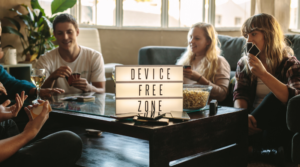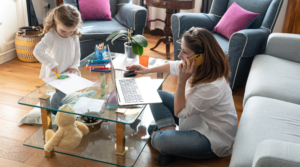
Work-Home Tech
Digital technology (DigiTech) use within a family context
In 2018, 95% of UK households owned a smartphone, up from 80% mobile phone ownership in 2007 (the year Apple launched its first iPhone) and 44% mobile ownership at the turn of the century.
Digital media has become an integral part of family life that is often intertwined and interspersed with numerous leisure and task-driven activities. Families are able to ‘micro-coordinate’ their lives and permit family events and activities to be arranged and changed spontaneously.
Although 25% of users say technology has made them feel overloaded and made their lives more complicated, parents often use technology in complex ways to keep on top of workloads and home commitments.
They perceive technology as ‘lifelines’ in helping to manage family leisure activities and commitments more easily – using gadgets to keep track of each other family members whereabouts and arrange family matters such as dinner time and arrival times back home.
This constant communication, for both parents and children, strengthens the feelings of safety, connection, intimacy and commitment. For mothers, this constant connectivity is perceived as part of their responsibility to be permanently available for their children, in case of emergency or if they need help – as a way of compensating for the physical separation occurring during the day and is considered a form of intimacy when the ability to physical connect is limited.
But, juggling it all is both labour-intensive and highly demanding and often requires complex and regular communication – with organisational skills akin to that of a professional project manager.
Additionally, in contemporary society, being a good friend and family member is increasingly correlated to how frequently you stay connected to others – continually receiving and sending updates. This continuous, spontaneous communication gives families and friends the ability to maintain intimacy and contact while not being physically present – a real advantage in today’s global and mobile economy.
Work-supplied technology use
The 2016 Steelcase Report, on work-owned technology use amongst UK office workers, showed that 38% were given mobile phones, 39% laptops and 12% tablets for work purposes. At the time 77% had desktop computers and only 39% had access to video conferencing facilities.
Workers who are supplied with work-based devices are more likely to engage with work after hours, than are those who use personal devices to access work-based digital communications during their private time.
Company-supplied laptops and mobiles are used in slightly different ways:
- Mobiles are likely to be used more often than laptops, as mobiles allow workers to rapidly review and respond to communications and are primarily used for calls, emails and text-based message communication.
- Laptops are more likely to be used for a wider range of activities including engaging with documents, answering emails, replying to instant messages and internet browsing
Regardless of the technology used, most monitoring of emails and work-based communication takes place during traditional downtime, such as commuting, travelling and waiting, rather than during more active periods such as dinner with friends and while with family.
Personal DigiTech use at home for work purposes
in 2018, home-owned technology use amongst UK households showed that: 95% used smartphones, 67% used laptops, 64% used desktops and 61% used tablets.
Almost every employee in Western society can access work-based emails via their digital gadgets and, almost half of these are constantly checking their emails (even if they have not received a notification) and sleeping with their phone next to their bed so they do not miss any calls or updates.
This constant preoccupation with checking incoming messages during waking hours, in addition to the use of mobiles for unpaid work communication in the evenings and on weekends, is done in order for the worker to feel that they are coping with their workload.
Even when workers understand the potential disadvantages of after-hours work, they choose to engage in it anyway due to the benefits it provides and the lifestyle choices it allows.
This means that employees are Always on, Always Available, and have greater opportunity to become distracted, both at home during personal time and during working hours by work and personal emails, notifications, a social media and news feeds.
Work and personal digital technology layering
Prior to the widespread availability and use of smartphones, (around 2008) the majority of mobile phone use in private time was not work-based. Only around 30-40% of workers made between 1 to 3 work calls during private time, in contrast to 90% of workers who engaged with their mobile for private communication use.
Improvements in technology and the rise of the smartphone have allowed more people to use DigiTech for work purposes during private time.
Work-home technology using boundary management strategies.
Our working culture has made it acceptable and, sometimes expected, for workers to read and respond to work-based messages and emails during private hours.
Family and friends also tend to expect an almost immediate response to emails and messages – whatever the time of day or night, sometimes becoming upset if there is no response within a short space of time.
Having to carry around and juggle multiple devices, apps and expectations, it can become difficult to mentally shut off from DigiTech use. This is especially true when work and personal technology and apps are merging onto fewer devices – ‘layering’ the management of both personal and professional communication requirements on top of each other all day- every day..
For some this constant juggling can become overwhelming. For others, it can be a bit of an obsession.
Each of us has different strategies for either separating or blurring the lines between work and home responsibilities. If you haven’t already, you can read more about this in Chapter 1 ‘Work-Home Boundary Blurring’.
Workers tend to use differing strategies to separate out home and work and the digital technology they use to merge or delineate the two realms. This includes, but is not limited to:
- Shutting down work-based software
- Proactively reconfigure device usage and which Apps are no longer used or useful and minimising your App library.
- Using different devices for work and private use, such as a laptop for work and a laptop for ‘private’ activities such as communicating with family, and friends, leisure activities and distraction.
- Having separate accounts on a single device – logging in and out of each depending on the time of day and focus.
- Reducing or minimising multiple device juggling or simultaneous device use
Whatever technology is used for work-based digital communication in private time, it will still have some impact on the worker, their family, and the organisation they work for.
Create a ‘Digital Use Strategy’.
If you do want to become more purposeful in how you manage all your digital devices and communication, you may need to develop a personal ‘Digital Use Strategy’. Some tips on how to do this include:
- Identify those trigger points for you that seem to elevate your stress levels.
- Are the work- or private-related triggers most prevalent during work or private time – i.e. are they being negatively disruptive at a contrasting time of the day to when you need to be most productive, focussed or present (i.e. are you getting work emails during private time or visa versa)?
- What is your ideal strategy for dealing with each of these ‘life-realm interruptions’ and what are the steps you can slowly implement to change/train your technology use or the behaviour of others going forward?
- Add a 3-month recurring meeting in your diary to consider your current technology use and re-work your technology use strategy depending on any observations you have about your technology use, and the psychological and emotional impact it may have on you and those around you.
Almost everything we do at work is facilitated by technology. This is increasingly true of our home life functions too.
Often we adopt new technologies that have the indirect consequence of changing our behaviours and home and workplace expectations of both ourselves and others.
We need to take a step back every now and then to assess how these useful tools are affecting us psychologically, emotionally and physically – for better or worse.
If we do not spend time understanding the short, medium and longer-term impact of digital use in the workplace, we may find ourselves having to retrospectively try to fix norms and cultures that are not helping worker wellbeing – and at the end of the day, potentially negatively affecting the overall bottom line.
It is important, therefore, to semi-regularly sensor-check our technology adoption and use to optimise how we work, live and play, rather than simply engaging with and purchasing new gadgets that potentially negatively facilitate and impact our stress, anxiety and longer-term mental wellness.
If you do decide to replace any current or purchase any new technology, think through (and potentially write down):
- What benefits the technology has, or how it will add value to, in your life/attention/productivity levels/work flow/etc.
- What situations, places or times you will use this technology and what boundaries you intend to put in place for its use.
A reminder of what the acronyms mean:
DigiTech: Digital Technology










